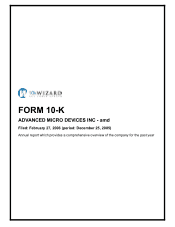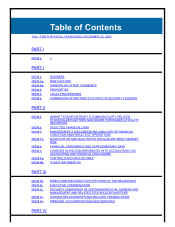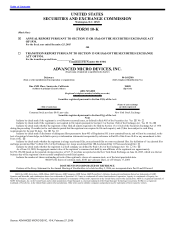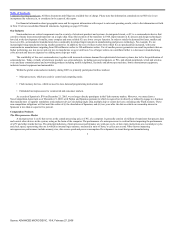AMD 2005 Annual Report Download - page 8
Download and view the complete annual report
Please find page 8 of the 2005 AMD annual report below. You can navigate through the pages in the report by either clicking on the pages listed below, or by using the keyword search tool below to find specific information within the annual report.
Table of Contents
[email protected]. All these documents and filings are available free of charge. Please note that information contained on our Web site is not
incorporated by reference in, or considered to be a part of, this report.
For financial information about geographic areas and for segment information with respect to sales and operating results, refer to the information set forth
in Note 10 of our consolidated financial statements, beginning on page 107 below.
Our Industry
Semiconductors are critical components used in a variety of electronic products and systems. An integrated circuit, or IC, is a semiconductor device that
consists of many interconnected transistors on a single chip. Since the invention of the transistor in 1948, improvements in IC process and design technologies
have led to the development of smaller, more complex and more reliable ICs at a lower cost per function. In order to satisfy the demand for faster, smaller and
lower-cost ICs, semiconductor manufacturers have continually developed improvements in manufacturing and process technology. For example, ICs are
increasingly being manufactured using smaller geometries. In addition, the size of silicon wafers from which ICs are produced has increased, with some
semiconductor manufacturers migrating from 200-millimeter wafers to 300-millimeter wafers. Use of smaller process geometries can result in products that are
higher performing, use less power and cost less to manufacture on a per unit basis. Use of larger wafers can contribute further to a decrease in manufacturing
costs per unit and increase capacity by yielding more chips per wafer.
The availability of low-cost semiconductors, together with increased customer demand for sophisticated electronic systems, has led to the proliferation of
semiconductors. Today, virtually all electronic products use semiconductors, including personal computers, or PCs, and related peripherals, wired and wireless
voice and data communications and networking products including mobile telephones, facsimile and photocopy machines, home entertainment equipment,
industrial control equipment and automobiles.
Within the global semiconductor industry, during 2005 we primarily participated in three markets:
• Microprocessors, which are used for control and computing tasks;
• Flash memory devices, which are used to store data and programming instructions; and
• Embedded microprocessors for commercial and consumer markets.
As a result of Spansion’s IPO on December 21, 2005, we no longer directly participate in the Flash memory market. Moreover, we entered into a
Non-Competition Agreement as of December 21, 2005, with Fujitsu and Spansion pursuant to which we agreed not to directly or indirectly engage in a business
that manufactures or supplies standalone semiconductor devices (including single chip, multiple chip or system devices) containing only Flash memory. These
non-competition obligations will last until the earlier of (i) the dissolution of Spansion, and (ii) two years after the date on which our ownership interest in
Spansion is less than or equal to five percent.
Computation Products
The Microprocessor Market
A microprocessor is an IC that serves as the central processing unit, or CPU, of a computer. It generally consists of millions of transistors that process data
and control other devices in the system, acting as the brain of the computer. The performance of a microprocessor is a critical factor impacting the performance
of a PC and other similar devices. The principal indicators of microprocessor performance are work-per-cycle, or how many instructions are executed per cycle,
and clock speed, representing the rate at which its internal logic operates, measured in units of hertz, or cycles per second. Other factors impacting
microprocessor performance include memory size, data access speed and power consumption. Developments in circuit design and manufacturing
3
Source: ADVANCED MICRO DEVIC, 10-K, February 27, 2006





















